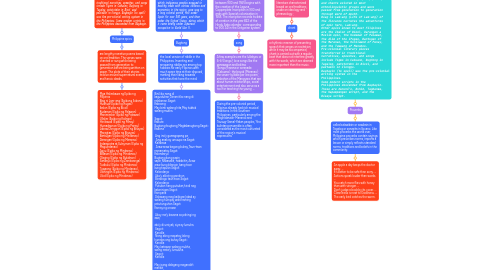
1. Pre-colonial literary pieces transferred in traditional narratives, speeches, and songs include Tigmo in Cebuano, Bugtong in Tagalog, patototdon in Bicol, and paktakon in Ilonggo. Baybayin (to spell) was the pre-colonial writing system in the Philippines. Some modern scripts in the Philippines descended from Baybayin.
1.1. Philippine epics
1.1.1. are lengthy narrative poems based on oral tradition. The verses were chanted or sung while being passed from generation to generation before being written on paper. The plots of their stories revolve around supernatural events and heroic deeds.
1.1.1.1. Mga Halimbawa ng Epiko ng Pilipinas Biag ni Lam-ang (Epikong Ilokano) Hudhud (Epiko ng Ifugao) Ibalon (Epiko ng Bicol) Kudaman (Epiko ng Palawan) Manimimbin (Epiko ng Palawan) Ullalim (Epiko ng Kalinga) Hinilawod (Epiko ng Panay) Humadapnon (Epiko ng Panay) Labaw Donggon (Epiko ng Bisayas) Maragtas (Epiko ng Bisayas) Bantugan (Epiko ng Mindanao) Darangan (Epiko ng Maranao) Indarapatra at Sulayman (Epiko ng Maguindanao) Agyu (Epiko ng Mindanao) Bidasari (Epiko ng Mindanao) Olaging (Epiko ng Bukidnon) Sandayo (Epiko ng Zamboanga) Tudbulul (Epiko ng Mindanao) Tuwaang (Epiko ng Mindanao) Ulahingan (Epiko ng Mindanao) Ulod (Epiko ng Mindanao)
2. The islands' precolonial period, during which indigenous peoples engaged in healthy trade with various cultures and economies in the region, gave way to a long colonial period, first under Spain for over 300 years, and then under the United States, during which it came briefly under Japanese occupation in World War II.
2.1. Bugtong
2.1.1. the local version of riddle in the Philippines. Inventing and answering riddles are among top hobbies for early Filipinos with much spare time at their disposal, marking their liking towards activities that hone the mind.
2.1.1.1. Binili ko nang di kagustuhan,Ginamit ko nang di nalalaman.Sagot: Kabaong May binti walang hita,May tuktok walang mukha. Sagot: Kabute Bugtong-bugtong,Magkakarugtong.Sagot: Kadena Ang ina’y gumagapang pa, Ang anak ay umuupo na.Sagot: Kalabasa Araw araw bagong buhay,Taun-taon namamatay.Sagot: Kalendaryo Bugtong kong sapin sapin,Nakasabit, nakabitin, Araw araw kung bilangin,Isang taon kung tapusin.Sagot: Kalendaryo Ako’y aklat ng panahon, Binabago taun taon.Sagot: Kalendaryo Putukan nang putukan,hindi nag kakarinigan.Sagot: Kampana Dalawang mag kaibigan,lakad ay walang humpay,wala naming patutunguhan.Sagot: Kamay ng orasan Akoy ma’y kasama sa pahingi ng awa; ako’y di umiyak, siya ay lumuha. Sagot: Kandila Nang aking mapatay,lalong humaba ang buhay.Sagot: Kandila May katawan walang mukha, walng mata’y lumuluha. Sagot: Kandila May isang dalagang maganda’t marikit, hindi lumalaki kundi lumiliitSagot: Kandila Naririto si Pascualita,hila-hila ang bitukaSagot: Karayom at sinulid Makina kong si Maheno,nasa puwit ang prenoSagot: Karayom at sinulid Isang senyora,
3. The history of the Philippines between 900 and 1565 begins with the creation of the Laguna Copperplate Inscription in 900 and ends with Spanish colonisation in 1565. The inscription records its date of creation in the year 822 of the Hindu Saka calendar, corresponding to 900 AD in the Gregorian system.
3.1. song
3.1.1. A few examples are the lullabyes or Ili-ili (Ilongo); love songs like the panawagon and balitao (Ilongo);harana or serenade (Cebuano); the bayok (Maranao); the seven-syllable per line poem, ambahan of the Mangyans that are about human relationships, social entertainment and also serve as a tool for teaching the young; ...
3.1.1.1. During the pre-colonial period, Filipinos already had rich musical traditions. In the Southern Philippines, particularly among the Magindanaon-Maranao and Tausug-Samal-Yakan peoples, “the kulintang ensemble is often considered as the most cultivated of the region's musical expressions”
4. Pre-Colonial period literature characterized based on oral traditions, crude on ideology and phraseology.;
4.1. chant
4.1.1. a rhythmic manner of presenting speech that verges on recitation; while it may be accompanied, chant is carried out with a regular beat that does not interfere greatly with the words, which are deemed more important than the music.
5. Philippine folk tales, epics, poems, and chants existed in most ethnolinguistic groups and were passed from generation to generation through word of mouth. Biag ni Lam-ang (Life of Lam-ang) of the Ilocanos narrates the adventures of epic hero, Lam-ang. Other epics known to most Filipinos are the Ibalon of Bikol, Darangan a Muslim epic, the Kudaman of Palawan, the Alim of the Ifugao, Bantugan of the Maranao, the Hinilawod of Panay, and the Tuwaang of Manobos. Pre-colonial literary pieces transferred in traditional narratives, speeches, and songs include Tigmo in Cebuano, Bugtong in Tagalog, patototdon in Bicol, and paktakon in Ilonggo. Baybayin (to spell) was the pre-colonial writing system in the Philippines. Some modern scripts in the Philippines descended from Baybayin. Those are Hanunó’o, Buhid, Tagbanwa, the Kapampangan script, and the Bisaya script.
5.1. Proverbs
5.1.1. called salawikain or sawikain in Tagalog or sarsarita in Ilocano. Like most proverbs the world over, Philippine proverbs contain sayings which prescribes norms, imparts a lesson or simply reflects standard norms, traditions and beliefs in the community.
5.1.1.1. An apple a day keeps the doctor away. ... It's better to be safe than sorry. ... Actions speak louder than words. ... You catch more flies with honey than with vinegar. ... Don't judge a book by its cover. ... Cleanliness is next to Godliness. ... The early bird catches the worm.
